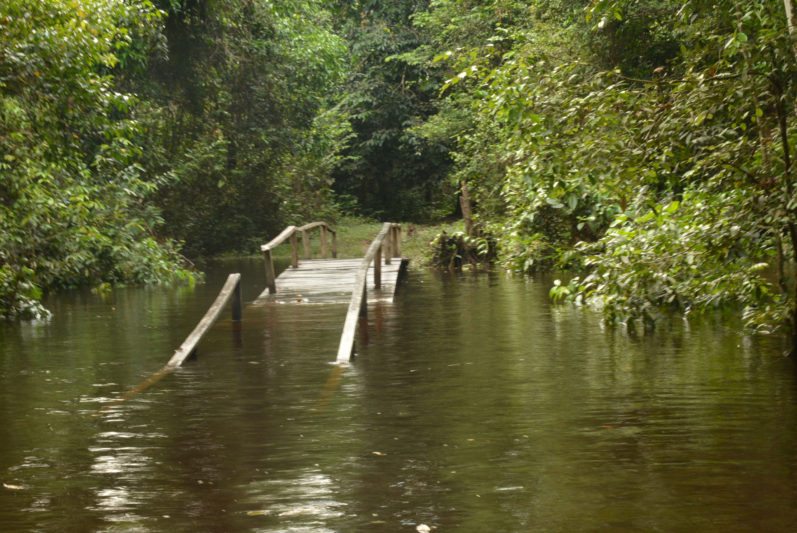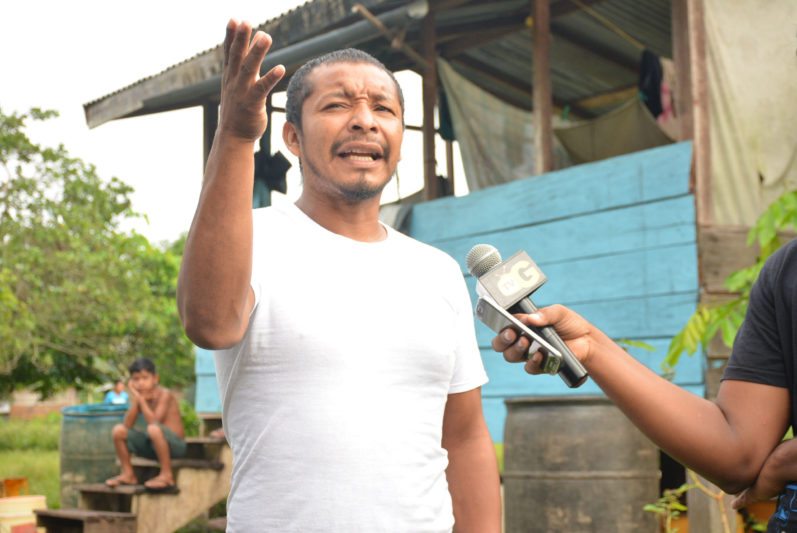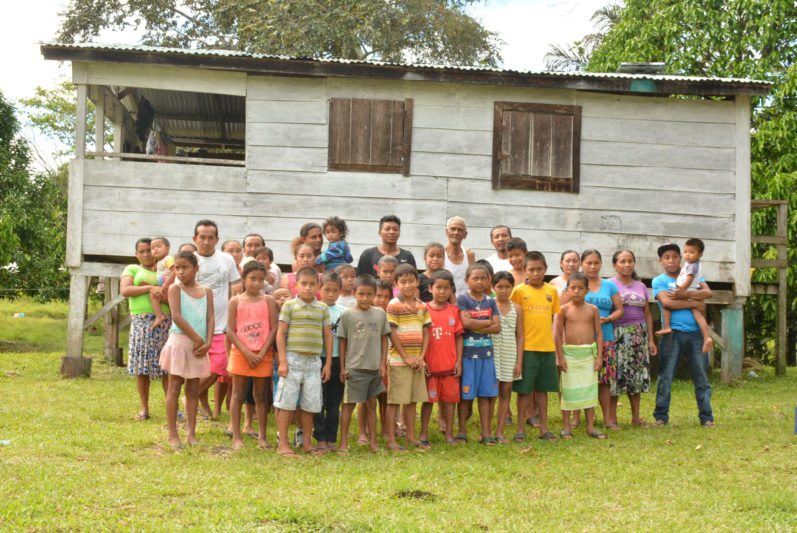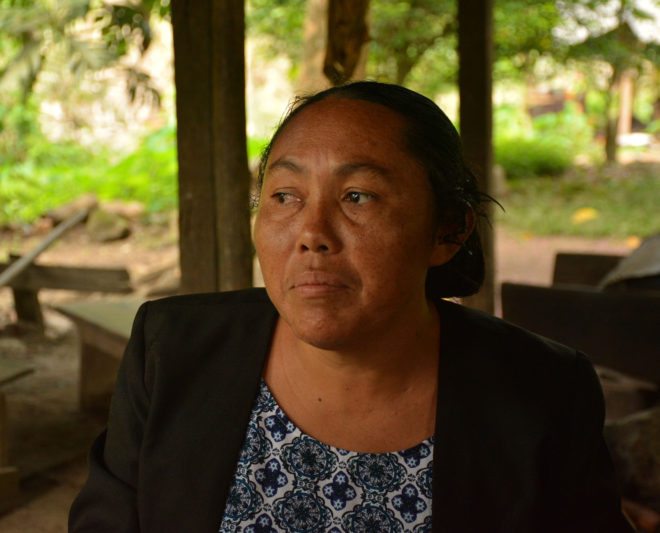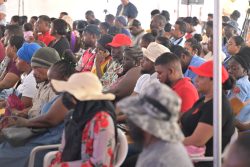Photos by Mariah Lall
One month after heavy rainfall caused severe flooding, residents of Chenapau Village, Region Eight (Potaro/Siparuni) are struggling to get back on their feet.
Chenapau resident Nick Carter told Stabroek News during this newspaper’s visit to the village last week, that though the community had experienced similar floods in 2004, last month’s incident still managed to catch them off guard.
“We were going about our normal lives, you know, going to the backdam and those things when the rain started suddenly. One whole day and one whole night of rain and the waters crept up on up as while we slept. The force of the water even pushed one of my uncle’s house from its original position into a bush… Other houses were totally covered by the water leaving some people practically homeless,” he shared.
“The Toshao had to act and I remember hearing someone say that no one will die in a day, but truthfully that was when we needed the help the most… The Toshao couldn’t have done it by himself.”
It was then that a village meeting was called to strategize a plan of action to help those affected by the flood.
“It was one of the largest village meetings we had in a long time and we had persons just crying because you know some people lost almost everything… I really don’t know how to explain to you how people feel, even to this day people are stalled up because they don’t know where to go or what to do,” Carter said.
Another major setback for the village was the damage to farmlands since the water covered in excess of 20 farms, destroying more the crops. Not only does this raise the possibility of a food shortage in the future, but annual heritage celebrations scheduled for September have also been postponed to the following year.
“We usually plant our ground provisions particularly our cassava which is our main staple but you see when the water rise everything was covered; we had to catch boat to go there and when we were there we were just passing over the plants,” Carter said.
“Normally we use the cassava we reap from our farms to make our indigenous drinks and foods for heritage celebrations but this year everything was just squashed,” he added.
Higher ground
For Sylvester Joseph, the hardest part of the situation for him was not being able to save everyone’s belongings.
“When we realized that water was going into the houses we tried to evacuate as much as we could. Like we all saw those mainly affected were those who had houses close to the waterfront but we could not do much in terms of saving stuff because a lot of those persons were away in the backdam… We tried to break into these places to save whatever we could,” he related.
Asked about the possibility of persons relocating from areas so close to the river, Joseph said, “Indeed, I think the people said they were going to move to higher ground but for the sake of access to water they chose to build closer to the river.”
It was with this consideration that a proposal was made to the Guyana Water Inc (GWI) for the establishment of a gravity flow water supply system, which would see persons higher up in the hills being able to access water as opposed to depending on the river as is the case right now.
“We have since identified a hill where water is and we can use that to supply the village; GWI has given us a response and we hope to see that project begin soon,” he added.
Meanwhile Drusilla McGarrell, Head teacher of the Chenapau Primary School, said the floods had affected students’ attendance for two days since no one showed up due to their inability to traverse the river.
“I had no children at all for two days because the rain was falling heavily and the river was streaming too hard for them to come up with boat,” she related.
In the days that followed, however, McGarrell said, with assistance from the Regional Education Officer they were able to transport close to 90 students to and from school. While the water has receded somewhat, a few roads and at least one access bridge are still covered, thus they continue to shuttle the students to and from school.
Thankful for life
“The morning my wife went to school walking but the afternoon we had to seek boat to reach back home because everywhere was covered with water. It really destroyed us, the whole village felt the impact…. Food stuff in the kitchen were swept away… when we woke up the next morning we had nothing to eat,” Carter related.
“Normally the children are happy when they have school because a lot of times some of those children don’t have anything to eat when the morning come or when the evening come so they depend on the hot meals provided by the school at lunch,” he added.
With the expected food shortages, parents will have to consider how they will cope during the upcoming August vacation.
“In 2004 when we had the flood we took three to four years to catch back ourselves… People are studying what it would be like next year. We as big people we can hold our strain but it is the little children… When the morning come they run to their mom to say they hungry and she turns to me and as daddy I have to find something because daddy has no one to run to,” Carter said.
Meanwhile, alluding to the recent detention of 21 Chenapau residents in the Kaieteur National Park (KNP) on allegations of illegal mining in the park, Carter said they cannot yet get back on their feet since the presence of the Guyana Defence Force in the park impedes their free movement.
Maintaining the claim that all mining activities carried out by Chenapau residents are done well beyond the KNP boundary, the man said the ongoing military operation in the park hinders residents’ access to their camps on the other side.
“I thought to myself that I had to go back to the backdam because that was the fastest way to get money, but to this day I can’t go because I have to study how I going to pass through there without being arrested. I have started considering heading to Mahdia, but to do that I have to find between $60,000 and $70,000… as opposed to walking through the trail in the park which is free,” the man contended.
“Everyone in Chenapau facing the same situation right now but I believe that as a village we have to come together to support each other and build back from the disaster. It will take some time for us to come back to where we were but I know we will be able to do it eventually,” he added.
Despite all that has happened, residents say they are thankful that no life was lost.
“We had houses under water, some of them were twisted which means people can’t live back in those structures and they have to start all over again. But even with all of that, we are really thankful that no life was lost,” Valerie Carter said, before commending the Toshao as “he did a great lot for his people.”
Several other villages were similarly flooded in Region Seven (Cuyuni/ Mazaruni) and other parts of Region Eight.

